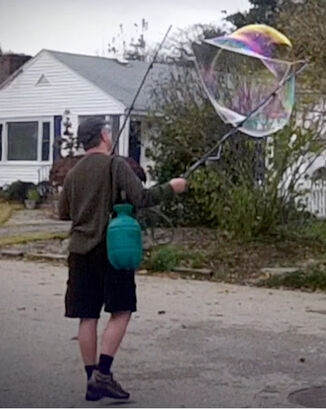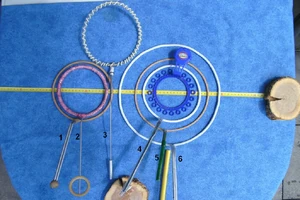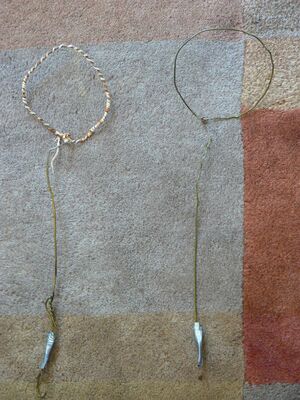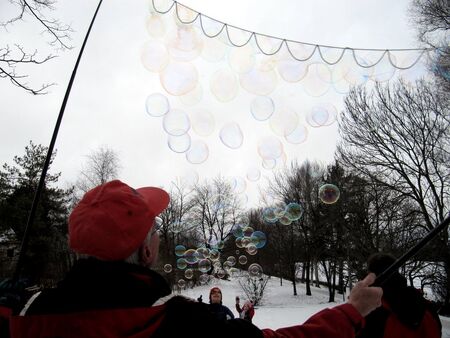mNo edit summary |
(→NoDip Wand/System: fix link. refine language) |
||
| Line 46: | Line 46: | ||
{{ClearFloat}} |
{{ClearFloat}} |
||
==NoDip Wand/System== |
==NoDip Wand/System== |
||
| − | + | The [[NoDip System]] is a simple and effective setup for feeding a soap solution & establish a soap film on a Tri-String (or other sort of) wand. ''NoDipping'' frees strolling bubblers from their buckets & much, much more. See the [[NoDip System]] page for more information including instructions on building your own. |
|
[[File:KMJ_NoDip_Vers_1_documentation_2012.jpg|thumb|left|326px|Valve is in right hand.]] |
[[File:KMJ_NoDip_Vers_1_documentation_2012.jpg|thumb|left|326px|Valve is in right hand.]] |
||
| Line 82: | Line 82: | ||
{{ClearFloat}} |
{{ClearFloat}} |
||
| + | |||
==Wire Wands== |
==Wire Wands== |
||
Clothes-hanger wire is a great material for making wands as you can bend it into a large variety of shapes and sizes. Simply unravel the hanger. Bend one end of the wire to make some sort of closed shape. Bend the handle with an angle convenient for dipping into a tray. You can use a pie tin as a dip tray. Lastly, wrap the looped part of the wand with cotton twine or cotton yarn. The string/yarn makes it much easier to make bubbles with this type of wand than if you leave the wire bare. Aluminum rods can also be used; aluminum rod is inexpensive, strong, easy to work with and can often be found at the local hardware or home improvement store. |
Clothes-hanger wire is a great material for making wands as you can bend it into a large variety of shapes and sizes. Simply unravel the hanger. Bend one end of the wire to make some sort of closed shape. Bend the handle with an angle convenient for dipping into a tray. You can use a pie tin as a dip tray. Lastly, wrap the looped part of the wand with cotton twine or cotton yarn. The string/yarn makes it much easier to make bubbles with this type of wand than if you leave the wire bare. Aluminum rods can also be used; aluminum rod is inexpensive, strong, easy to work with and can often be found at the local hardware or home improvement store. |
||
Revision as of 15:13, 10 August 2013
| Popular Pages | |
|---|---|
|
Getting Started |
|
|
Getting Deeper |
Ingredients,Test Matrix,Controversies,Questions,E's Bubble Blog |
|
Contact |
|
Bubble wands come in a large variety of shapes and sizes and may not be wand-like at all. A variety of common household materials can be used to create bubbles from tiny to whale-size. Making your own wands can be edifying and a great project for kids, parents or parents and kids together.
Most people find that their homemade wands work better than manufactured wands -- and they are considerably less expensive. You can make a tri-string wand wand suitable for creating 20 to 30 foot long bubbles tubes for only a few dollars -- less if you have the materials on hand.
Types of Wands
Wands can be traditional plastic wands that come in bottles of commercial bubble solution but they can be made from just about anything -- even your hands can be used to blow bubbles (if they are wet). Great wands can be made from drinking straws, string, wire hangers, and even paper. Paper cones can be made to blow basketball-sized bubbles and bubble domes (as demonstrated in the videos below).
Paper Cones. The soccer ball size bubbles in the video below were created with paper cones like the ones documented at Bubble Town.
| thumb|500px|right|These bubbles were created with a simple paper cone and solution that is ultra dawn, water and glycerine. |
[MORE INFO AND PICTURES NEEDED] Please help this page grow -- and add pictures of your favorite wands!
Tri-String
Tri-string wands are the most popular type of wand for making giant bubbles. They can be be small or large and are very easy to make. A basic tri-string wand (also called a tri-wand) consists of a a loop of string (or other material) attached to a pair of handles (which could be as simple as pencils, chopsticks or bamboo gardening stakes).
They can be used to make bubbles from small to whale-size depending on the size of the loop.
Read all about them on the page Tri-String Wands
Garland Wand
A Garland Wand or Bubble Garland is a variant of the tri-string design. It consists of two handles that are attached to a series of looplets. Find out more about garland wands.
Garland Wands are a variation of the tri-string design. More about Garland wands.
NoDip Wand/System
The NoDip System is a simple and effective setup for feeding a soap solution & establish a soap film on a Tri-String (or other sort of) wand. NoDipping frees strolling bubblers from their buckets & much, much more. See the NoDip System page for more information including instructions on building your own.

Valve is in right hand.
Wire Wands
Clothes-hanger wire is a great material for making wands as you can bend it into a large variety of shapes and sizes. Simply unravel the hanger. Bend one end of the wire to make some sort of closed shape. Bend the handle with an angle convenient for dipping into a tray. You can use a pie tin as a dip tray. Lastly, wrap the looped part of the wand with cotton twine or cotton yarn. The string/yarn makes it much easier to make bubbles with this type of wand than if you leave the wire bare. Aluminum rods can also be used; aluminum rod is inexpensive, strong, easy to work with and can often be found at the local hardware or home improvement store.

A collection of handmade hoops and a plastic commercial hoop.







